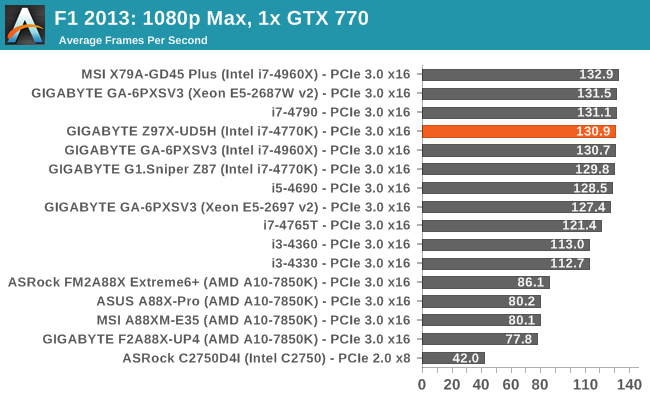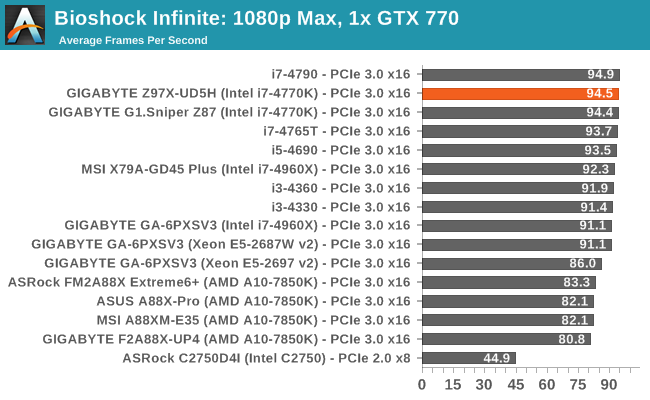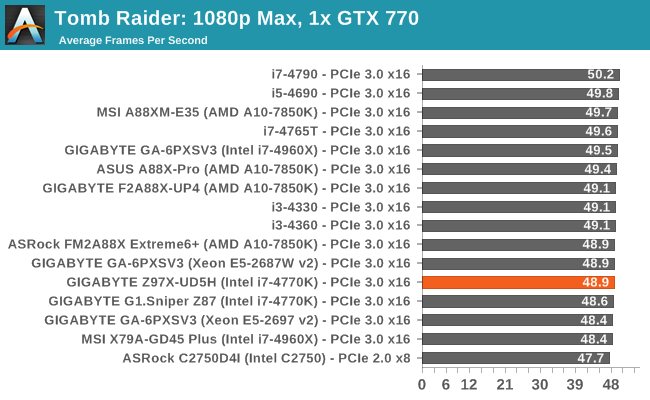GIGABYTE Z97X-UD5H Review: Choose Your Storage Option
by Ian Cutress on May 14, 2014 9:00 AM EST- Posted in
- Motherboards
- Intel
- Gigabyte
- Z97
Gaming Benchmarks
F1 2013
First up is F1 2013 by Codemasters. I am a big Formula 1 fan in my spare time, and nothing makes me happier than carving up the field in a Caterham, waving to the Red Bulls as I drive by (because I play on easy and take shortcuts). F1 2013 uses the EGO Engine, and like other Codemasters games ends up being very playable on old hardware quite easily. In order to beef up the benchmark a bit, we devised the following scenario for the benchmark mode: one lap of Spa-Francorchamps in the heavy wet, the benchmark follows Jenson Button in the McLaren who starts on the grid in 22nd place, with the field made up of 11 Williams cars, 5 Marussia and 5 Caterham in that order. This puts emphasis on the CPU to handle the AI in the wet, and allows for a good amount of overtaking during the automated benchmark. We test at 1920x1080 on Ultra graphical settings.

| F1 2013, 1080p Max | ||
| NVIDIA | AMD | |
| Average Frame Rates |
|
|
| Minimum Frame Rates |
|
|
Bioshock Infinite
Bioshock Infinite was Zero Punctuation’s Game of the Year for 2013, uses the Unreal Engine 3, and is designed to scale with both cores and graphical prowess. We test the benchmark using the Adrenaline benchmark tool and the Xtreme (1920x1080, Maximum) performance setting, noting down the average frame rates and the minimum frame rates.

| Bioshock Infinite, 1080p Max | ||
| NVIDIA | AMD | |
| Average Frame Rates |
|
|
| Minimum Frame Rates |
|
|
Tomb Raider
The next benchmark in our test is Tomb Raider. Tomb Raider is an AMD optimized game, lauded for its use of TressFX creating dynamic hair to increase the immersion in game. Tomb Raider uses a modified version of the Crystal Engine, and enjoys raw horsepower. We test the benchmark using the Adrenaline benchmark tool and the Xtreme (1920x1080, Maximum) performance setting, noting down the average frame rates and the minimum frame rates.

| Tomb Raider, 1080p Max | ||
| NVIDIA | AMD | |
| Average Frame Rates |
|
|
| Minimum Frame Rates |
|
|













53 Comments
View All Comments
Ian Cutress - Wednesday, May 14, 2014 - link
At this point, it is more up to the motherboard manufacturer and what they implement.The chipset diagrams will show you how the slots are arranged, and which can be used at the expense of others. We will try and add these as we go forward.
As for protocols, it is all AHCI right now.
Jon-Tech - Wednesday, May 14, 2014 - link
I wanted to ask about USB controllers. Are all the USB 2.0 ports using one controller? Are the USB 3.0 ports on the same controller? Also from the sounds of it, the extra USB 3.0 ports are just using a hub rather than an extra controller? Due to my setup I often run into USB bandwidth issues with lots of ports on one controller. So I'm looking at motherboards that have as many as possible for more flexibility and none of the review sites ever seem to mention how many there are!Regarding the z97 chipset, it appears that the xHCI Host Controller supports up to 6 USB 3.0 and 14 USB 2.0, this sounds like one controller. It also has two EHCI Host Controllers which support up to 14 external USB 2.0, though it doesn't look like any of the motherboards are using these. From the sounds of it this motherboard runs all the ports off the single controller? That strikes me as being daft and therefore unlikely, could you shed any light onto what the actual USB controller set up is please? I'm also unclear on how USB affects the PCIe lanes...
repoman27 - Thursday, May 15, 2014 - link
The Z97 chipset contains one xHCI which supports 14 USB ports, up to 6 of which can be USB 3.0. It also contains 2 legacy EHCI host controllers which can be used in lieu of the xHCI for USB 2.0 ports, but there are still only external connections for 14 USB ports total.With this board, it appears that Gigabyte has connected a motherboard header and the two back panel USB 3.0 ports above the HDMI port directly to the PCH xHCI, and then used a Renesas USB 3.0 hub chip to expand an additional PCH xHCI connection to support the other four back panel ports.
The PCH is connected to the CPU via a DMI 2.0 x4 link, which is equivalent to PCIe 2.0 x4, and thus provides a maximum of 16 Gbit/s less protocol overhead of total bandwidth for all PCH attached devices. Obviously the nominal bandwidth of just 6 USB 3.0 ports is greater than that. What isn't so obvious is how the various controllers within the PCH are connected to the PCIe bus internally. From the benchmarks I've seen of previous chipsets, it would appear that the xHCI only has the equivalent of an x2 connection. This still makes it one of the fastest USB 3.0 controllers out there since the only discrete controller I know of with an x2 back end is the Etron EJ198. Seeing as most motherboard manufacturers use discrete controllers with x1 back ends and connect them to PCIe lanes coming from the PCH, the performance generally sucks. If you need more than 785 MB/s of USB 3.0 bandwidth, you'd be better off buying a card like the HighPoint RocketU 1144C and sticking it in a slot that uses some of the PEG lanes coming from the CPU.
Jon-Tech - Thursday, May 15, 2014 - link
Thanks repoman, you've been the most insightful into this from all the various places I've asked! That HighPoint card looks spot on though it's rather pricey, especially considering my old mobo has 3 controllers on it for the 2x USB 3.0 and 12x USB 2.0. Though I only know the amount of controllers cause I have it and can check.Seems the only way I'm going to actually find out controllers per motherboards is to ask owners on forums to check for me. It's a really quick test that reviewers could do and its just as annoying it's never listed in the official mobo specs! Alternatively I could buy and try them out for myself though that doesn't seem practical.
Adriak - Wednesday, May 14, 2014 - link
Why are there still (conventional) PCI slots on motherboards? Didn't they become obsolete when PCIe arrived in 2004? I understand these slots are likely added for legacy reasons, but are people still using PCI cards? What type of cards are they? Was the ISA bus supported for this long after it was effectively rendered obsolete? I am genuinely curious.Nathan539 - Wednesday, May 14, 2014 - link
This would save me some money for my new comp that im buildingpeterfares - Wednesday, May 14, 2014 - link
Are people still using PCI devices on consumer boards? What could you possibly need to add that goes into PCI for home use?fluxtatic - Thursday, May 15, 2014 - link
Sound cards. If you're not using the Asus Xonar or a Turtle Beach card, odds are good your discrete card is PCI.Luay79 - Thursday, May 15, 2014 - link
Do you lose the 16 lanes for the single video card if you use M2/SAta Express SSDs?DanNeely - Thursday, May 15, 2014 - link
No. See the block diagram at the bottom of the first page. The 16 CPU lanes go to the 16x physical slots. The M2/SataExpress connectors use lanes from the southbridge.